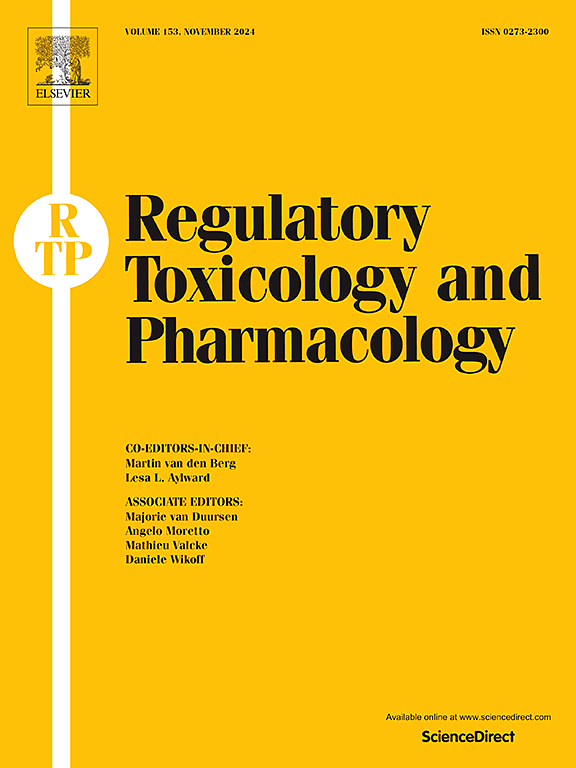评价农药生态风险评价的高通量分析方法
IF 3.5
4区 医学
Q1 MEDICINE, LEGAL
引用次数: 0
摘要
评估农药生态风险对监管至关重要,但传统的脊椎动物测试是资源密集型的,并且具有伦理挑战性。新的方法方法,如高通量测定(hta),提供了具有成本效益、机制明确的替代方法,减少了动物的使用。美国环保署的ToxCast项目包含HTA数据,用于化学筛选,但其在生态风险评估(ERA)中的应用仍未得到充分利用。我们将ToxCast数据直接应用于ERA指标,将分析得出的暴露-活动比与来自监管评估的体内风险商数(RQs)进行比较。独特的是,我们的研究侧重于农药,关注风险而不是危害,利用了直接从相同的标准化监管风险评估中获取的数据,为决策提供信息。虽然与体内rq相比,ToxCast检测通常低估了风险,特别是对于慢性终点,但某些检测,如细胞色素P450检测,显示出除草剂和杀菌剂的强一致性。相比之下,针对光合作用的神经毒性杀虫剂和除草剂的分析性能较弱,反映了这些作用模式的HTA覆盖范围的差距。我们的研究结果强调了hta作为ERA的补充工具的潜力,特别是在筛选和优先排序方面,尽管需要进一步开发针对慢性和特定作用方式风险的检测方法。将HTA数据整合到风险度量中,为促进更准确、更有效和更合乎道德的农药评价方法奠定了基础。本文章由计算机程序翻译,如有差异,请以英文原文为准。
Evaluating high-throughput assays for pesticide ecological risk assessment
Evaluating pesticide ecological risk is essential for regulation, but traditional vertebrate testing is resource-intensive and ethically challenging. New approach methodologies, such as high-throughput assays (HTAs), offer cost-effective, mechanistically explicit alternatives that reduce animal use. The US EPA's ToxCast program houses HTA data for chemical screening, but its use in ecological risk assessment (ERA) remains underutilized. We applied ToxCast data directly to ERA metrics, comparing assay-derived exposure–activity ratios to in vivo risk quotients (RQs) from regulatory assessments. Uniquely, our study focuses on pesticides and is risk-focused rather than hazard-focused, leveraging data drawn directly from the same standardized regulatory risk assessments that inform decision-making. While ToxCast assays generally underestimated risks compared to in vivo RQs—particularly for chronic endpoints—certain assays, such as cytochrome P450 assays, demonstrated strong alignment for herbicides and fungicides. In contrast, assay performance was weaker for neurotoxic insecticides and herbicides targeting photosynthesis, reflecting gaps in HTA coverage for these modes of action. Our findings underscore the potential of HTAs as complementary tools for ERA, particularly for screening and prioritization, though further assay development is needed for chronic and mode-of-action-specific risks. Integrating HTA data into risk metrics lays the groundwork for promoting more accurate, efficient, and ethical approaches to pesticide evaluation.
求助全文
通过发布文献求助,成功后即可免费获取论文全文。
去求助
来源期刊
CiteScore
6.70
自引率
8.80%
发文量
147
审稿时长
58 days
期刊介绍:
Regulatory Toxicology and Pharmacology publishes peer reviewed articles that involve the generation, evaluation, and interpretation of experimental animal and human data that are of direct importance and relevance for regulatory authorities with respect to toxicological and pharmacological regulations in society. All peer-reviewed articles that are published should be devoted to improve the protection of human health and environment. Reviews and discussions are welcomed that address legal and/or regulatory decisions with respect to risk assessment and management of toxicological and pharmacological compounds on a scientific basis. It addresses an international readership of scientists, risk assessors and managers, and other professionals active in the field of human and environmental health.
Types of peer-reviewed articles published:
-Original research articles of relevance for regulatory aspects covering aspects including, but not limited to:
1.Factors influencing human sensitivity
2.Exposure science related to risk assessment
3.Alternative toxicological test methods
4.Frameworks for evaluation and integration of data in regulatory evaluations
5.Harmonization across regulatory agencies
6.Read-across methods and evaluations
-Contemporary Reviews on policy related Research issues
-Letters to the Editor
-Guest Editorials (by Invitation)

 求助内容:
求助内容: 应助结果提醒方式:
应助结果提醒方式:


